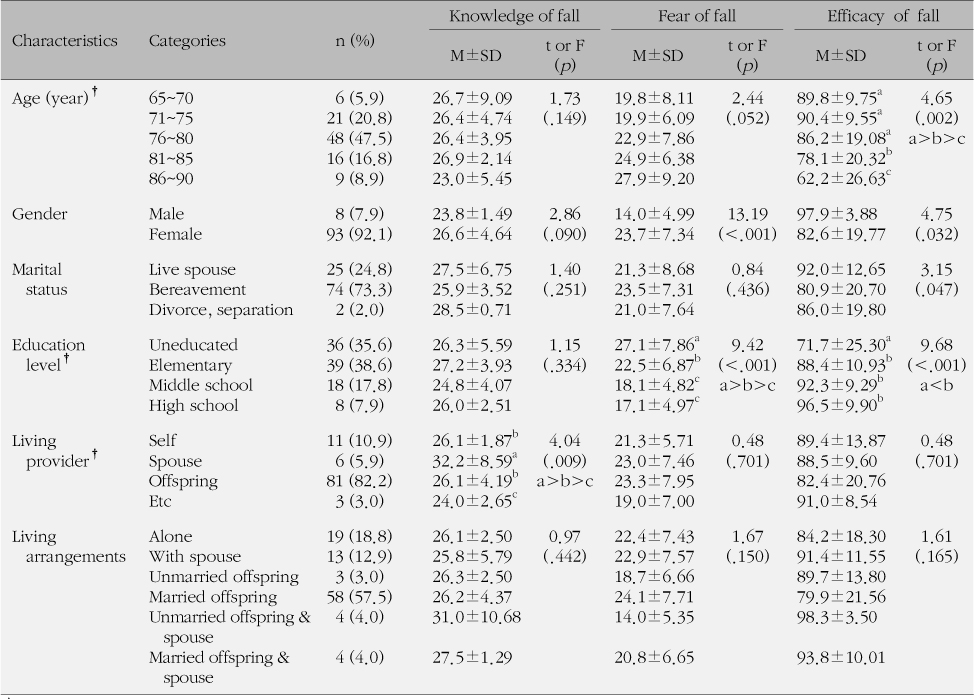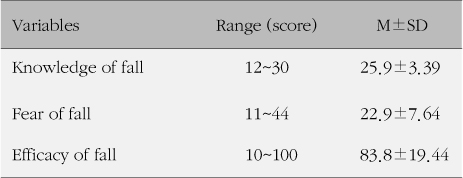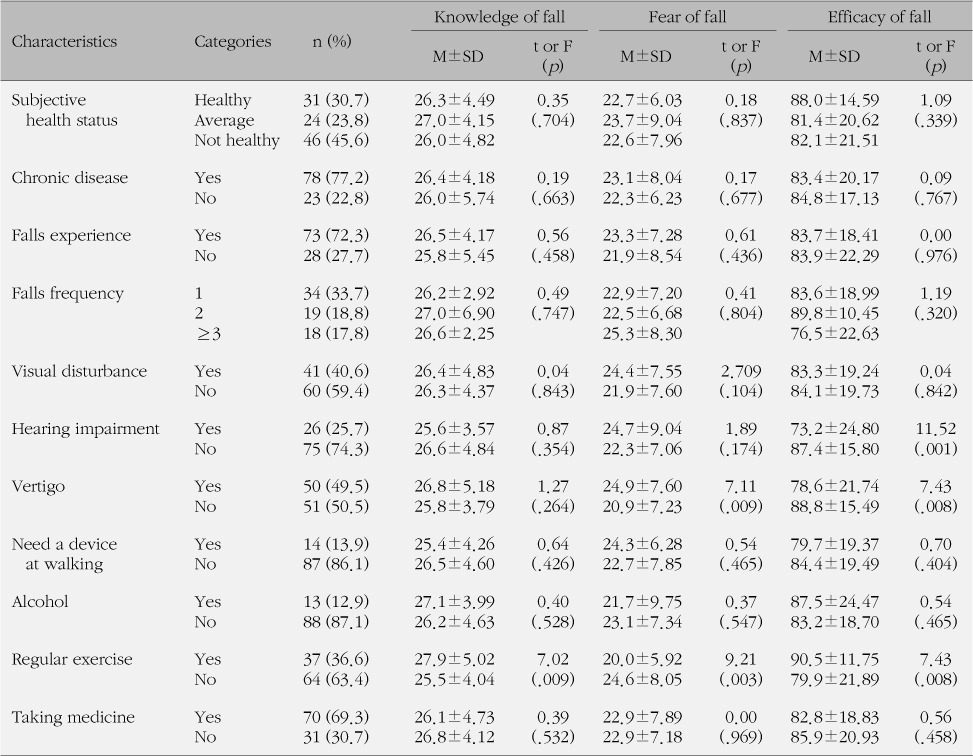Articles
- Page Path
- HOME > J Korean Acad Community Health Nurs > Volume 21(2); 2010 > Article
-
Original Article
- Relations among Knowledge, Fear and Efficacy of Fall in the Community Dwelling Elderly
- Myung Soon Kwon
-
Journal of Korean Academy of Community Health Nursing 2014;21(2):139-147.
DOI: https://doi.org/10.12799/jkachn.2010.21.2.139
Published online: April 4, 2014
Associate Professor, Division of Nursing, Hallym University, Korea.
• Received: April 22, 2010 • Revised: June 15, 2010 • Accepted: June 16, 2010
© 2010 Korean Academy of Community Health Nursing
This is an Open Access article distributed under the terms of the Creative Commons Attribution Non-Commercial License (http://creativecommons.org/licenses/by-nc/3.0/) which permits unrestricted non-commercial use, distribution, and reproduction in any medium, provided the original work is properly cited.
- 534 Views
- 0 Download
- 10 Crossref
Abstract
-
Purpose
- This study was to find out knowledge, fear, and efficacy of fall in the community dwelling elderly and to investigate how the factors were connected to one another.
-
Methods
- Data were collected from June to August, 2009 from 101 aged people who aged 65 or older and agreed to participate in this study sampled among elders at 8 halls of the aged in local communities. The subjects were interviewed by a co-researcher and 3 trained assistants in a way of responding to the questionnaire after being read. The data were analyzed through t-test, ANOVA, Turkey's test and Pearson correlation coefficients.
-
Results
- Knowledge of fall was affected significantly by whether the living cost was provided or not, fear of fall was affected by sex, level of education, hearing impairment and regular exercise, and efficacy of fall was affected by age, sex, marital status, level of education, hearing impairment, vertigo and regular exercise. The results also showed a negative correlation between fear of fall and efficacy of fall.
-
Conclusion
- According to this study, regular exercise can build up knowledge and efficacy of fall and diminish fear of fall. Thus it is highly recommended to include regular exercise in an effective fall-prevention program.
Table 2Differences in Knowledge, Fear and Efficacy of Fall according to the Demographic Factors (N=101)


-
This research was supported by Basic Science Research Program through the National Research Foundation of Korea(NRF) funded by the Ministry of Education, Science and Technology(2009-0068282).
NOTES
- 1. Chang CM. A structural model for falls and quality of life in elderly people living at home. Seoul: Kyung Hee University; 2005. Unpublished doctoral dissertation.
- 2. Chang CM, Kang HS. Physical function and psychological status in the elderly those who experienced a fall or not. Korean J Rehabil Nurs. 2004;7(1):48–57.
- 3. Choi JH. The effects of Tai Chi exercise on physiologic, psychological functions, and fall in fall prone elderly. Seoul: Catholic University of Korea; 2002. Unpublished doctoral dissertation.
- 4. Cumming RG, Salkeld G, Thomas M. Prospective study of the impact of fear of falling on activities of daily living, SF-36 scores, and nursing home admission. J Gerontol A Biol Sci Med Sci. 2000;55(5):M299–M305. ArticlePubMed
- 5. Deshpande N, Metter EJ, Bandinelli S, Lauretani F, Bandinelli S, Windham BG, et al. Activity restriction induced by fear of falling and objective and subjective measures of physical function: A prospective cohort study. J Am Geriatr Soc. 2008;56(4):615–620. ArticlePubMedPMC
- 6. Friedman SM, Munoz B, West SK, Rubin GS, Fried LP. Falls and fear of falling: Which comes first? A longitudinal prediction model suggests strategies for primary and secondary prevention. J Am Geriatr Soc. 2002;50(8):1329–1335. ArticlePubMed
- 7. Hakim RM, Roginski A, Walker J. Comparison of fall education methods for primary prevention with community-dwelling older adults in a senior center setting. J Geriatr Phys Ther. 2007;30(2):60–68. PubMed
- 8. Hur JY. Knowledge and attitude toward falls among elderly inpatients. Seoul: Yonsei University; 2007. Unpublished master's thesis.
- 9. Hyeon IS. The effects of a fall prevention program on the knowledge, efficacy, and preventive actions of falls among the low-income elderly. Daegu: Keimyung University; 2008. Unpublished master's thesis.
- 10. Jung D. A prediction model of fear of falling in older adults living in a continuing-care retirement community (CCRC) in United States. J Korean Gerontol Soc. 2009;29(1):243–258.
- 11. Kim SJ. Risk factors of falling in the elderly in urban cities. Seoul: Ewha Womans University; 2004. Unpublished master's thesis.
- 12. Kim SW, Yang YJ, Eo KS, Cho HJ, Kim YS. Fear of falling in elderly persons living in a home for the aged. J Korean Acad Fam Med. 1998;19(2):1400–1409.
- 13. Kressig RW, Worf SL, Sattin RW, O'Grady MA, Greenspan A, Curns A, et al. Associations of demographic, functional, and behavioral characteristics with activity-related fear of falling among older adults transitioning to frailty. J Am Geriatr Soc. 2001;49(11):1456–1462. ArticlePubMedPDF
- 14. Lee HY, Bak WS, Yang HI. Fear of falling and falls efficacy with bone mineral density in the middle and old aged women. J Muscle Joint Health. 2009;16(1):5–12.
- 15. Lee MS. Manan community health survey analysis. Anyang: Manan-gu elderly health center; 2007.
- 16. Li F, Fisher KJ, Harmer P, McAuley . Falls self-efficacy as a mediator of fear of falling in an exercise intervention for older adults. J Gerontol B Psychol Sci Soc Sci. 2005;60(1):P34–P40. ArticlePubMed
- 17. Nikolaus T, Bach M. Preventing falls in community-dwelling frail older people using a home intervention team (HIT): Results from the randomized falls-HIT trial. J Am Geriatr Soc. 2003;51(3):300–305. ArticlePubMed
- 18. Liu MR. The effects of Tai Chi exercise program on physical strength, fall related perception and health status in nursing home elderly. Daejeon: Chungnam National University; 2007. Unpublished master's thesis.
- 19. Rubenstein LZ, Josephson KR, Robbins AS. Falls in the nursing home. Ann Intern Med. 1994;121(6):442–451. ArticlePubMed
- 20. Salminen MJ, Vahlberg TJ, Salonoja MT, Aarnio PT, Kivela SL. Effect of a risk-based multifactorial fall prevention program on the incidence of falls. J Am Geriatr Soc. 2009;57(4):612–619. ArticlePubMed
- 21. Scheffer AC, Schuurmans MJ, Dijk N, Hooft T. Fear of falling: Measurement strategy, prevalence, risk factors and consequences among older persons. Age Ageing. 2008;37(1):19–24. ArticlePubMed
- 22. Seo HL, Kim SK, Yeom WS, Lee EC, Baek YH. The study on self-care status, activity of daily living and physical self-efficacy of aged people. J Res Inst Phys Educ. 1998;14:133–143.
- 23. Shaw FE. Prevention of falls in older people withdementia. J Neural Transm. 2007;114(10):1259–1264. ArticlePubMedPDF
- 24. Shumway-Cook A, Silver IF, LeMier M, York S, Cummings P, Koepsell TD. Effectiveness of a community-based multifactorial intervention on falls and fall risk factors in community-living older adults: A randomized controlled trial. J Gerontol A Biol Sci Med Sci. 2007;62(12):1420–1427. ArticlePubMed
- 25. Sohng KY, Moon JS, Kang SS, Choi JH. The survey of activities and fear of falling in the community dwelling elderly. J Korea Community Health Nurs Acad Soc. 2001;15(2):324–333.
- 26. Statistics Korea. Elderly statistics in 2008 2008;Retrieved February 10, 2010. from http://www.nso.go.kr
- 27. Tideiksaar R. Falling in old age. Prevention and Management. 2nd ed. New York: Spring Publishing Company; 1997.
- 28. Tinetti ME, Richman D, Powell L. Fall efficacy as a measure of fear of falling. J Gerontol. 1990;45:P239–P243.
- 29. Tinetti ME, Baker DI, Dutcher J, Vincent JE, Rozett RT. Reducing the risks falls among older adult in the community. Berkeley, CA: Peaceable Kingdom Press; 1997.
- 30. Vassallo M, Vignaraja R, Sharma JC, Briggs R, Allen S. The relationship of falls to injury among hospital inpatients. Int J Clin Pract. 2005;59:17–20. Article
Figure & Data
References
Citations
Citations to this article as recorded by 

- Latent classes based on fall risk factors in community‐dwelling older adults: The 2017 National Survey of Older Persons
Mi Yeon Kim, Jong Sun Ok, Heejung Choi
International Journal of Nursing Practice.2023;[Epub] CrossRef - Factors affecting the use of protective measures of farmers to prevent falling during the walnut collection period in Tuyserkan County
Saeid Bashirian, Salman Khazaei, Maryam Afshari, Ensiyeh Jenabi, Hamid Shokoohi, Zahra Zobdeh, Mehran Biglari, Behzad Gholamaliee
Archives of Trauma Research.2021; 10(3): 141. CrossRef - Understanding and Prevention of Fall-related Injuries in Older Adults in South Korea: A Systematic Review
Ki-taek Lim, Ji-eun Lee, Ha-eun Park, Su-young Park, Woochol Joseph Choi
Physical Therapy Korea.2019; 26(2): 34. CrossRef - The effect of a VR exercise program on falls and depression in the elderly with mild depression in the local community
Jong-Eun Yang, Tac-Young Lee, Jin-Kyung Kim
Journal of Physical Therapy Science.2017; 29(12): 2157. CrossRef - Factors influencing fall prevention nursing performance of hospital nurses
Keong-Sook Jang, Hae-Sook Kim
The Korean Journal of Emergency Medical Services.2016; 20(3): 69. CrossRef - A Structural Equation Model of Fall Prevention Behavior among Community-dwelling Older Adults with Osteoarthritis
Keong Sook Jang, Rhayun Song
Korean Journal of Adult Nursing.2015; 27(6): 684. CrossRef - A Predictive Model of Fall Prevention Behaviors in Postmenopausal Women
Hyun-Jung Jang, Sukhee Ahn
Journal of Korean Academy of Nursing.2014; 44(5): 525. CrossRef - Relations among Fall Efficacy, Perception of Fall Risk and Fall Prevention Behavior in the Frail Elderly at Home
Young-Hee Kim
Journal of the Korea Academia-Industrial cooperation Society.2013; 14(7): 3383. CrossRef - Analysis of Factors Influencing Risk of Fallings among Rehabilitation Patients with Impaired of Mobility: Focusing on Activities-specific Balance Confidence
Dongwook Han, Kyung-Yeon Park
Journal of Korean Academy of Fundamentals of Nursing.2013; 20(3): 220. CrossRef - Prevalence and correlates of fear of falling in Korean community-dwelling elderly subjects
Seonho Kim, Wi-Young So
Experimental Gerontology.2013; 48(11): 1323. CrossRef

 KACHN
KACHN



 PubReader
PubReader Cite
Cite

